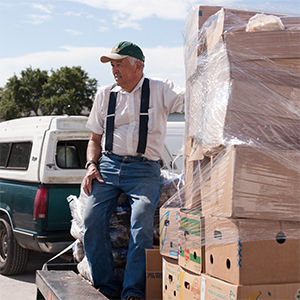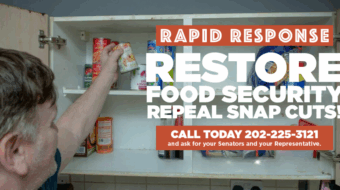
This week is National Food Bank Week, a great time to start thinking about helping others as the holiday season approaches. Food banks are, sadly, an all too necessary and ubiquitous feature of life in the United States today, where wages (if you’re employed) or the lack of wages (if you’re unemployed) just do not provide enough for sustenance for millions of people living in America. National Food Bank Week occurs each year during the week that also marks World Food Day on October 16, a day of action against hunger.
During this week, and especially on October 16, people around the world come together to declare their commitment to eradicate hunger in our lifetime. Because when it comes to hunger, the only acceptable number in the world is zero.
World Food Day celebrates the creation of the Food and Agriculture Organization of the United Nations (FAO) on October 16, 1945, in Quebec, Canada. First established in 1979, World Food Day has since been observed in almost every country by millions of people.
From hunger walks and World Food Day dinners to meal packaging events and food drives, there are many ways for people to be a part of solutions to hunger.
Each year, advocates come together to raise awareness and engage their neighbors in the movement to end hunger. Led by the FAO Liaison Office for North America, the World Food Day USA & Canada Network includes over 60 organizations, universities and companies that are working to achieve a zero hunger world.
In a world of plenty, 805 million people, one in nine worldwide, live with chronic hunger.The costs of hunger and malnutrition fall heavily on the most vulnerable:
• 60 percent of the hungry in the world are women.
• Almost five million children under the age of five die of malnutrition-related causes every year.
• Four in 10 children in poor countries are malnourished, damaging their bodies and brains.
Every human being has a fundamental right to be free from hunger and the right to adequate food. The right to adequate food is realized when every man, woman and child has the physical and economic access at all times to adequate food or means for its procurement.
We can end hunger in our lifetime. It’s possible. The world produces more than enough food to feed every person on the planet. In September 2000, world leaders signed a commitment to achieve eight Millennium Development Goals by 2015. MDG #1 is eradicate extreme poverty and hunger and includes three targets. Since then:
• Forty countries have already achieved the first target, to halve the proportion of people who suffer from hunger by 2015.
• In addition, over the past 20 years, the likelihood of a child dying before age five has been nearly cut in half, which means about 17,000 children are saved every day.
• Extreme poverty rates have also been cut in half since 1990.
The challenge is significant, but these results show that when we focus our attention, we can make big strides.
The cost of neglect is too high. No one in the world should have to experience hunger. In addition to the cost of human suffering, the world as a whole loses when people do not have enough to eat. Hungry people have learning difficulties, are less productive at work, are sick more often and live shorter lives. The cost to the global economy because of malnutrition is the equivalent of $3.5 trillion a year. Hunger leads to increased levels of global insecurity and environmental degradation. Ending hunger is not just a moral imperative, but also a good investment for society.
Hunger can happen to anyone.In the U.S., by many standards the richest country in the world, one in seven Americans – 14.3 percent – does not have enough to eat. Nutritious food can be expensive, making a balanced diet a luxury for many. Loss of a job, a family tragedy, poor health, or an accident can make anyone, anywhere, go hungry in a moment. Globally, extreme climate events, war, or even financial crisis can dramatically affect a person’s ability to feed themselves and their families. These small and large events can set off a cycle of hunger and poverty.
Some societies do better at feeding their people than others. In some countries hunger is virtually unknown. Is it merely a question of capitalism vs. socialism, or totalitarianism vs. the welfare state, or North vs. South, or religious vs. secular? No, it’s not that simple. Without adequate social safety nets, resiliency measures and good policy in place, whatever the system, hunger is bound to appear. It’s our job to set those nets, measures and policies in place, now and for everyone worldwide.
Source: World Food Day USA
Photo: Feeding America










